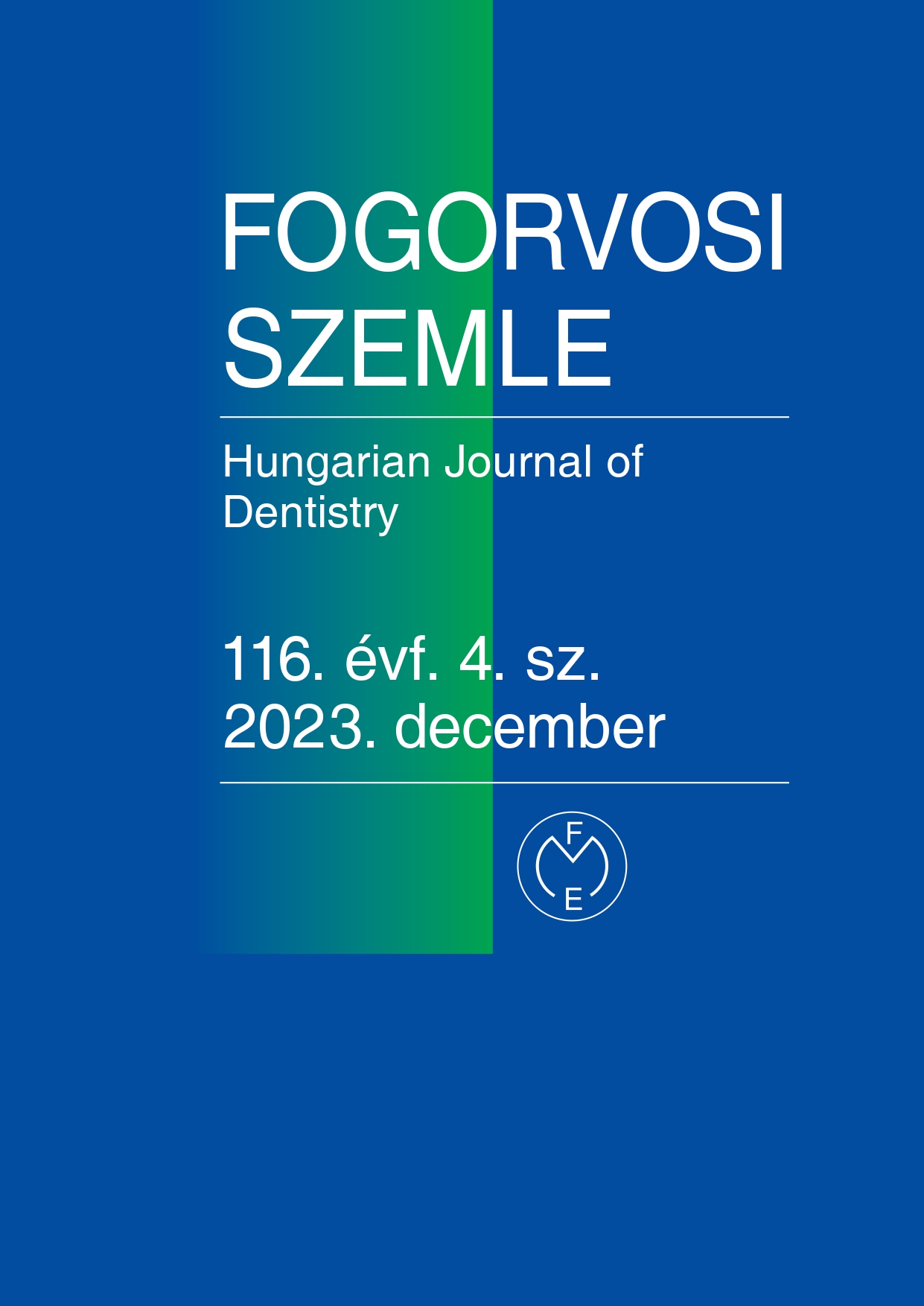Complex rehabilitation of erosive tooth wear with digital workflows
Abstract
Introduction: Erosive tooth wear, caused by a combination of exogenous and endogenous factors, affects both the appearance
and function of the entire dentition. Early diagnosis and treatment are crucial as the condition affects 30–45%
of the population and can result in the destruction of teeth, necessitating complex prosthetic rehabilitation.
Case report: Our 39-year-old patient visited the Department of Prosthodontics at Semmelweis University to have her
substantially worn teeth restored, which resulted in significant psychosocial deterioration. The pre-prosthetic treatment
plan included patient education, motivation, professional oral hygiene treatment, and initial Michigan splint therapy to acclimate
the neuromuscular system to the increased occlusal vertical dimension. Michigan splint was fabricated chairside
by building up a deep-drawn splint with self-curing acrylic resin. After three months of splint therapy, the process of creating
the definitive restoration began. A gothic-arch device was used to determine the vertical and horizontal relationship of
the jawbones. A digital face bow was used to establish the relationship between the upper jaw and the rotational axis as
well as the individual angle values. Then, both jawbones were scanned with an intraoral scanner. A digital smile design
was created and used for the design of the digital wax-up, which was then 3D printed to create a model. The patient tried
on the mock-up diagnostic pattern made of self-curing acrylic. The height and appearance of the mock-up were satisfactory;
therefore, tooth preparation could begin. After the preparation of the teeth digital impressions were taken. A newly
created mock-up that fits the prepared teeth held the bite height while the jaw relation was scanned. To ensure that the
final restoration was an exact copy of the accepted mock-up, the “copy-paste dentistry” concept was used. Long-term
temporary restorations were made of polymethyl methacrylate and were worn for one month. After the temporary phase,
restorations were milled from zirconia and luted with self-adhesive resin cement.
Summary: Erosive tooth wear occurs more and more frequently these days, which can not only affect function and
aesthetics but can also lead to psychosocial deterioration. During complex prosthetic rehabilitation, gnathological aspects
must be taken into account. Digital technologies could help create more predictable outcomes, increasing patient
satisfaction.
References
Aljomard YRM, Altunok EC, Kara HB: Enamel wear against monolithic zirconia restorations: A meta-analysis and systematic review of in vitro studies. J Esthet Restor Dent 2022; 34 (3): 473–489. https://doi.org/10.1111/jerd.12823
Bartlett D: A personal perspective and update on erosive tooth wear – 10 years on: Part 2 – Restorative management. Br Dent J 2016; 221 (4): 167–171. https://doi.org/10.1038/sj.bdj.2016.596
Coachman C, Bohner L, Jreige CS, Sesma N, Calamita M: Interdisciplinary guided dentistry, digital quality control, and the “copy-paste” concepts. J Esthet Restor Dent 2021; 33 (7): 982–991. https://doi.org/10.1111/jerd.12736
Donovan T, Nguyen-Ngoc C, Abd Alraheam I, Irusa K: Contemporary diagnosis and management of dental erosion. J Esthet Restor Dent 2021; 33 (1): 78–87. https://doi.org/10.1111/jerd.12706
Picos AM, Petean I, Picos A, Dadarlat-Pop A, Rachisan AL, Tomsa AM, et al: Atomic force microscopy analysis of the surface alterations of enamel, dentin, composite and ceramic materials exposed to low oral pH in GERD. Exp Ther Med 2021; 22 (1): 673. https://doi.org/10.3892/etm.2021.10105
Rosten A, Newton T: The impact of bulimia nervosa on oral health: A review of the literature. Br Dent J 2017; 223 (7): 533–539. https://doi.org/10.1038/sj.bdj.2017.837
Sch lueter N, Amaech i BT, Bartlett D, Buzalaf MAR, Carvalho TS, Ganss C, et al: Terminology of Erosive Tooth Wear: Consensus Report of a Workshop Organized by the ORCA and the Cariology Research Group of the IADR. Caries Res 2020; 54 (1): 2–6. https://doi.org/10.1159/000503308
Schlueter N, Luka B: Erosive tooth wear – a review on global prevalence and on its prevalence in risk groups. Br Dent J 2018; 224 (5): 364–370. https://doi.org/10.1038/sj.bdj.2018.167
Sun S, Liang R, Ren J, Xu Y, Zhao Y, Meng H: [Influence of polishing and glazing on the wear of zirconia and enamel]. Zhonghua Kou Qiang Yi Xue Za Zhi, 2016; 51 (5): 300–304. DOI: 10.3760/cma.j.issn.1002-0098.2016.05.010
Copyright (c) 2023 Authors

This work is licensed under a Creative Commons Attribution 4.0 International License.


.png)




1.png)



